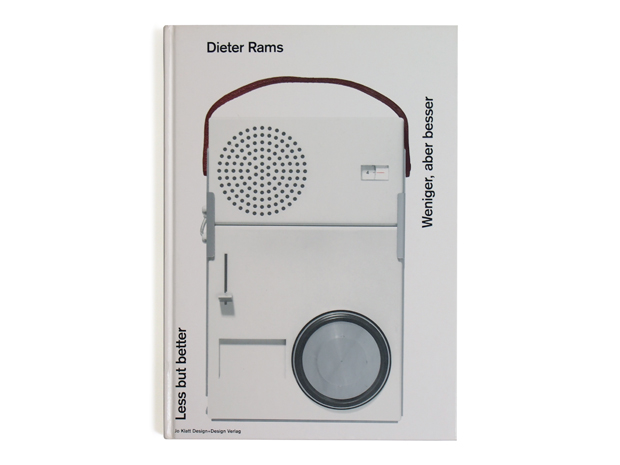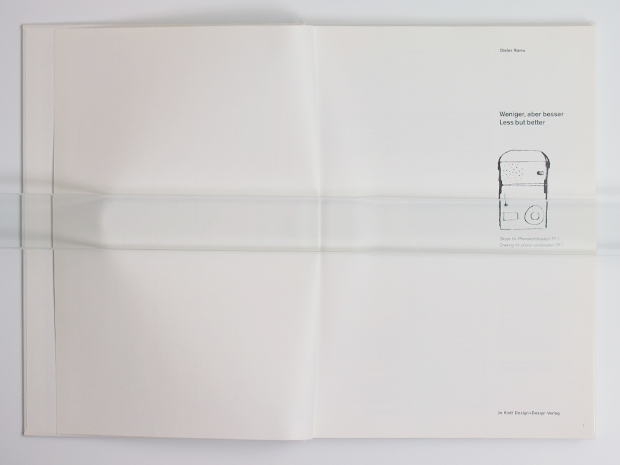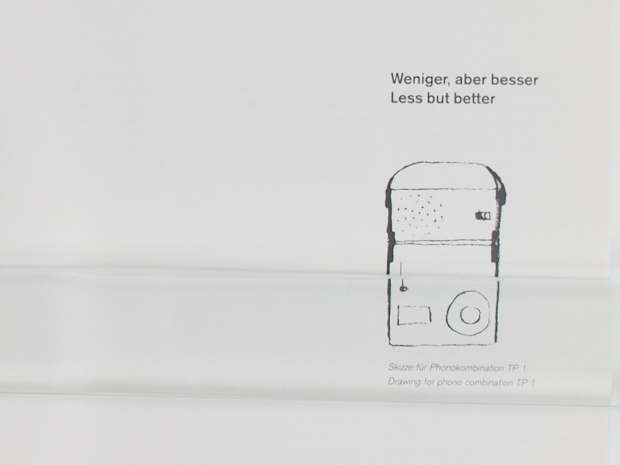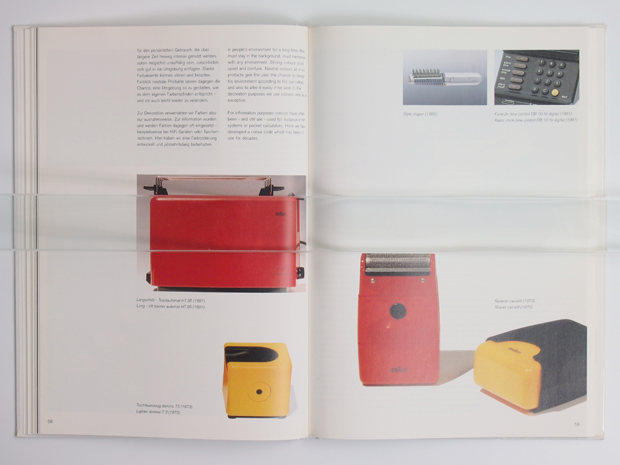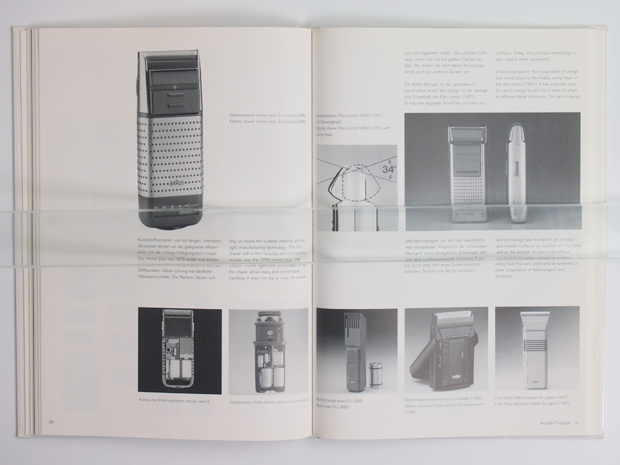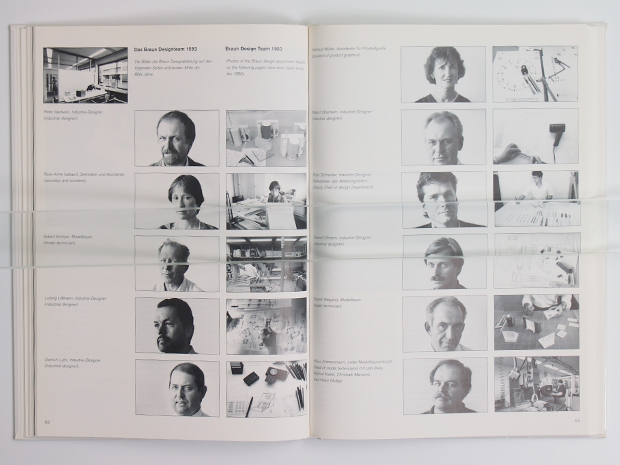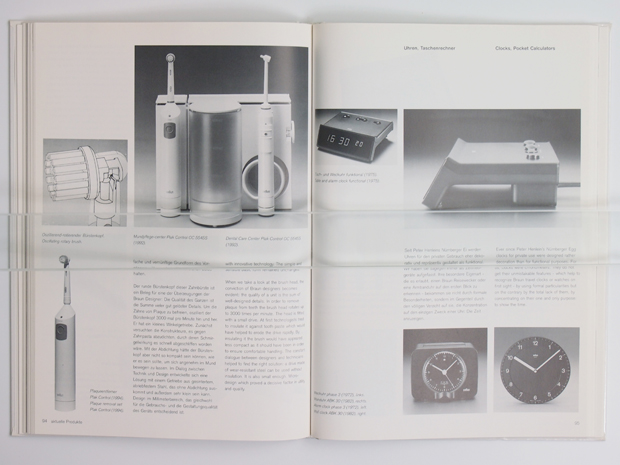Publisher: Klatt, Jo
ISBN-10: 3980348512
ISBN-13: 978-3980348515
Product Dimensions: 30 x 21.4 x 1.6 cm
Release Date: 1994
amazon stock for your reference
Dieter Rams (born May 20, 1932 in Wiesbaden, Hessen) is a German industrial designer closely associated with the consumer products company Braun and the Functionalist school of industrial design.
Rams’ ten principles of “good design”
Good design
Is innovative – The possibilities for innovation are not, by any means, exhausted. Technological development is always offering new opportunities for innovative design. But innovative design always develops in tandem with innovative technology, and can never be an end in itself.
Makes a product useful – A product is bought to be used. It has to satisfy certain criteria, not only functional, but also psychological and aesthetic. Good design emphasizes the usefulness of a product whilst disregarding anything that could possibly detract from it.
Is aesthetic – The aesthetic quality of a product is integral to its usefulness because products are used every day and have an effect on people and their well-being. Only well-executed objects can be beautiful.
Makes a product understandable – It clarifies the product’s structure. Better still, it can make the product clearly express its function by making use of the user’s intuition. At best, it is self-explanatory.
Is unobtrusive – Products fulfilling a purpose are like tools. They are neither decorative objects nor works of art. Their design should therefore be both neutral and restrained, to leave room for the user’s self-expression.
Is honest – It does not make a product more innovative, powerful or valuable than it really is. It does not attempt to manipulate the consumer with promises that cannot be kept.
Is long-lasting – It avoids being fashionable and therefore never appears antiquated. Unlike fashionable design, it lasts many years – even in today’s throwaway society.
Is thorough down to the last detail – Nothing must be arbitrary or left to chance. Care and accuracy in the design process show respect towards the consumer.
Is environmentally friendly – Design makes an important contribution to the preservation of the environment. It conserves resources and minimizes physical and visual pollution throughout the lifecycle of the product.
Is as little design as possible – Less, but better – because it concentrates on the essential aspects, and the products are not burdened with non-essentials. Back to purity, back to simplicity.
ディーター・ラムス(1932年5月20日、ドイツ、ヴィースバーデン生まれ)は、ドイツのインダストリアルデザイナーで、家電製品メーカーであるブラウン社と密接に関わるとともに、インダストリアルデザインにおける「機能主義」派の人物。
ラムスは、1943年から1957年にかけてヴィースバーデン製作技術学校で建築ならびに大工技術を習得した。 1953年から1955年まで建築家オットー・アペルのもとで働いた後、電気機器メーカーであるブラウンに入社、1961年よりデザイン部門のディレクターとして1995年まで勤務した。
ラムスはかつて、自らのデザインアプローチを「Weniger, aber besser」、つまり「Less, but better(より少なく、しかしより良く)」と語ったことがある。 ラムスと彼のスタッフは、ブラウン社で記憶に残る数多くの製品をデザインしているが、そのなかには有名なSK-4レコードプレーヤーや優れた品質をそなえた35 mmフィルムスライドプロジェクター「D」シリーズ(D45、D460) がある。 彼はまた、1960年にVitsœ社が発表した606 Universal Shelving Systemをデザインしたことでも知られている。
コーヒーメーカー、計算機、ラジオ、オーディオ/ヴィジュアル機器、消費家電およびオフィス機器など、彼が手がけたデザインの多くは、ニューヨークのニューヨーク近代美術館など、世界中のさまざまな博物館の収蔵品となっている。 ディーター・ラムスは、1998年に退社するまで、 30年以上にわたりBraun A.G.のデザイン部門のトップとして活躍した。 彼はなおデザイン業界において伝説的存在とされており、最近では雑誌Wallpaperのデザインも手がけている。
グッド・デザインの10の原則
1980年代初頭、ディーター・ラムスは社会の状況についてさらに深い懸念を抱くようになりました。「止むことのない形と色と騒音の不可解なまでの混乱」に満ちたこの世界に、ラムス自身が少なからぬ影響力を持っていることを自覚し、繰り返し自問していたのです。「自分のデザインは、グッド・デザインなのだろうか?」
グッド・デザインを「計る」ことはできませんから、考え続けるなかで最も大切だった10の原則を表すことでグッド・デザインを定義したのです(しばしば聖書になぞらえて『十戒』と呼ばれます)。
以下が「10の原則」です。
グッド・デザインは革新的
ものごとを革新していくための可能性が尽きることはない。技術の進化がつねに、革新的なデザインへの新たなチャンスを与えてくれる。しかし、革新的なデザインとは、つねに技術の革新とともに生み出されるものであり、デザインだけで完結することはない。
グッド・デザインは実用的
人は製品を使うために買う。その製品は機能面だけでなく、心理的、美的な面においても、一定の基準を満たしていなければならない。グッド・デザインとは、不要なものを可能な限り削ぎ落とし、実用性を最も重視したものだ。
グッド・デザインは美しい
製品は、日々それを使う人の個性、健康や暮らしの質にまで影響をおよぼすのだから、製品の実用性に美しさが加わることが欠かせない。しかしながら、ていねいに仕上げられたものだけが美しい。
グッド・デザインは説明不要
グッド・デザインは、製品の構造を際立たせる。さらに、製品が語りかけてくる。そして、最も優れたデザインは、それ自身ですべてを語る。
グッド・デザインはでしゃばらない
役割を果たすための製品は、道具のようなもの。装飾的なオブジェでも美術品でもない。使う人の個性を発揮する余白を残すためにも、デザインはニュートラルで控えめであるべきだ。
グッド・デザインは誠実
グッド・デザインは、製品を実際以上に革新的、強力、有用に見せたりはしない。守ることのできない約束で消費者を操るものではない。
グッド・デザインはながもち
グッド・デザインは、流行から距離を置く。そのため、古くなることもない。ファッショナブルな流行のデザインとは異なり、今日のような使い捨て社会にあっても、長く使われ続ける。
グッド・デザインはディテールまでが完璧
あいまいさや予測不能な要素をいっさい残してはならない。デザインをするうえでの細心さ、正確さは、消費者への誠意を示すものだ。
グッド・デザインは環境にやさしい
デザインとは、環境保全に大きな役割を担うものだ。製品がつくられ、その役割を全うするまでの間、資源を節約し、物理的に環境を汚染せず、そして見苦しいという視覚的な汚染もしてはならない。
グッド・デザインはほとんどデザインされていない
「Less, but better」——より少なく、しかもよりよく。それは、本質的な部分に集中するということ。それによって製品は、不要で過剰なデザインから開放される。
純粋で簡素、そこに立ち返ることだ。
“ただ他とちがって見せるためのデザインが、他より優れていることはほとんどない。他よりも優れたものにするためのデザインは、かならず他とはちがうものになる。”
ディーター・ラムス 1993年
“すべてのムダを削り取ることで、そのものの持つ本質を最良の状態で示すことが私のゴール。”
ディーター・ラムス 1980年
ヴィツゥ 606 ユニバーサル・シェルビング・システム ディーター・ラムス 1960年
